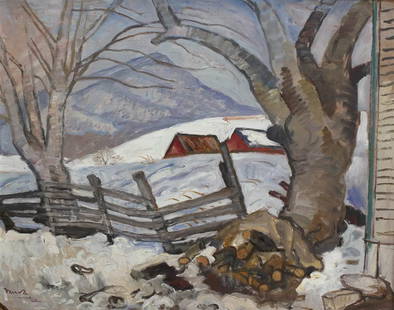
"MAESTRO PALMERO"; ALFREDO PALMERO DE GREGORIO (Ciudad Real, 1901 - Barcelona, 1991). "Parisian
Similar Sale History
View More Items in PaintingsRelated Paintings
More Items in Paintings
View MoreRecommended Art
View More







Item Details
Description
"MAESTRO PALMERO"; ALFREDO PALMERO DE GREGORIO (Ciudad Real, 1901 - Barcelona, 1991).
"Parisian terrace".
Oil on canvas.
Signed and located in Paris in the lower right corner.
Measurements: 65 x 55 cm; 88 x 77 x 5 cm (frame).
Of Neapolitan ancestry, Alfredo Palmero already manifests from his childhood a clear interest for the painting. In his adolescence, and in search of new horizons, in 1913 he moved to Madrid to enter the Academy of Fine Arts of San Fernando, when he was fourteen years old. There he was taught by Sorolla, Romero de Torres and Valle Inclán, the latter as professor of aesthetics. During these years he also frequently visited the studio of the photographer and painter Vicente Rubio Sánchez. Palmero became fully integrated into the bohemian atmosphere of the capital, and was a regular at the gatherings of well-known cafés such as "El Parnasillo" and "La Fontana de Oro", where the liberal and intellectual atmosphere was outstanding. There he made contact with Unamuno, Juan Ramón Jiménez, García Lorca and Manuel de Falla, among others. During these years, it was precisely the atmosphere of the cafés of the time, full of splendor and culture, that he would capture in his canvases. In 1920, after making his individual debut at the Casino of Ciudad Real, he left Madrid and moved to Paris, attracted by the pictorial novelties of the French capital. In this city he became interested in new trends such as Dadaism, and especially Apollinaire and other prominent figures of the time. At this stage he began to produce his moving and personal works, focused through a look of romantic heritage. His painting is filled with luminosity, rich chromatism, formal exuberance, sharpness in perspective and, above all, pictorial fantasy. Thus his paintings of the Folies Bergère, Pigalle, Montmartre, Montparnasse, etc. were born. He then made a series of trips to Germany, Italy and Belgium, where he portrayed, as he had already done in Madrid and Paris, the daily life of the cities. On his return to Spain he taught art in Ciudad Real, Burgos, Toledo and Barcelona, the latter city where he settled definitively in 1940. Barcelona became his platform to Europe and America, where he founded the Palmero Institute of Art. In 1964 he created the Palmero Museum in his native town, Almodóvar del Campo, in a mansion in La Mancha, where he used to spend his summers. In 1972 he was named Favorite Son of Almodóvar, and in 1983 he joined the Institute of La Mancha Studies. During his life, he exhibited his work both in Spain and abroad, in cities such as Osaka, Paris, Brussels, Florida, Bogota and Caracas. Maestro Palmero is currently represented in the museum that bears his name in Almodovar and in the museum of Don Quixote in Ciudad Real, as well as in private collections in Spain and abroad.
Buyer's Premium
- 26%
"MAESTRO PALMERO"; ALFREDO PALMERO DE GREGORIO (Ciudad Real, 1901 - Barcelona, 1991). "Parisian
Shipping & Pickup Options
Item located in Barcelona, -, esPayment
























































![Emilio Grau-Sala "Sur la Plage" Oil on Canvas: Emilio Grau-Sala (Spanish, 1911-1975), "Sur la Plage" [On The Beach], Oil on Canvas, 1958, signed "Grau Sala" lower right, signed, inscribed "Trouville", dated, and titled to verso. Image: 21.5" H x 2](https://p1.liveauctioneers.com/5649/328023/176731071_1_x.jpg?height=310&quality=70&version=1714409606)


















